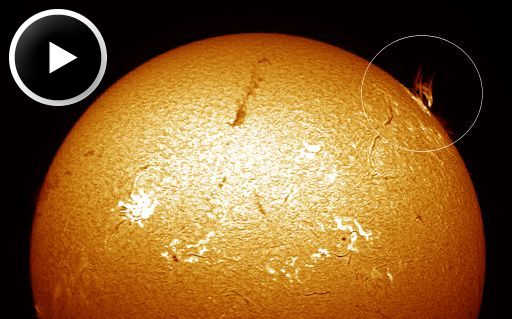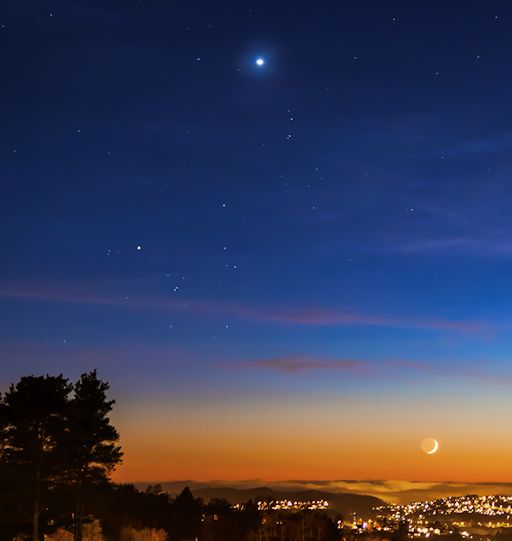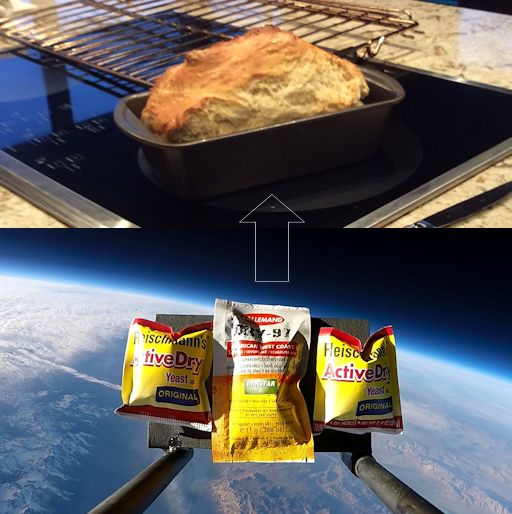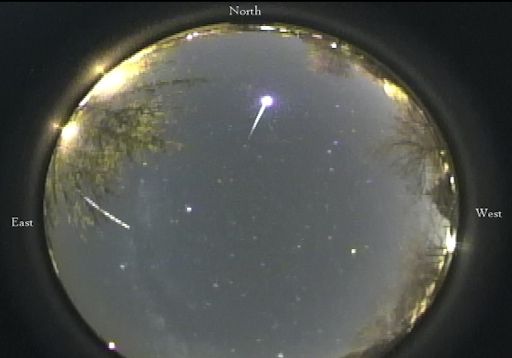Come to Tromsø and share Marianne's passion for rural photography: Chasethelighttours.co.uk invites you to experience "Heaven on Earth" with an aurora, fjord, fishing, whale watching, photography or sightseeing tour. | | |
CHANCE OF STORMS: NOAA forecasters estimate a 45% to 65% chance of polar geomagnetic storms during the next 12 to 36 hours. A solar wind stream and a CME are expected to hit Earth's magnetic field in quick succession, sparking G1-class disturbances on April 21st and 22nd. Aurora alerts: text, voice.
TINY ASTRONOMERS CATCH BIG SOLAR ACTIVITY: After days of low solar activity, explosions have commenced on both sides of the sun. Sunspot AR2322 near the sun's western limb has unleashed four M-class solar flares in the past 12 hours alone, while a magnetic filament rose up on the sun's eastern limb, creating a magnificent prominence. A group of 2nd graders in Columbus, Georgia, caught one of the M-flares in action:

"Ms. Getz's 2nd grade class at Forrest Road Elementary captured this incredible solar eruption during a session with the Real-time Interactive Solar Observatory," explains Mary Johnson, Assistant Director of the Coca-Cola Space Science Center at Columbus State University. Johnson and colleagues have been developing this online telescope for three years. "To give you an idea of what happens during these sessions, one of our staff members joins the school teacher in the classroom and accesses our telescope online. The students and teacher then use a control system to move the telescope and take images of the features they choose to view."
"Teachers from anywhere in the world can request online telescope sessions for their classes," she continues. "To learn more about this FREE resource, please visit http://observatory.ccssc.org/ or contact Michael Johnson at michaelj@ccssc.org."
Good news for tiny astronomers: More flares are in the offing. NOAA forecasters have boosted the odds of M-class eruptions to 30% on April 22nd. There is even a chance of X-flares, too--about 5%. Solar flare alerts: text, voice.
SUNSET SKY SHOW: When the sun goes down tonight, step outside and face west. Venus and the crescent Moon are beaming through the twilight side by side. Last night in Bergen, Norway, photographer Ronny Tertnes caught the Moon approaching Venus from below:

"It was an awesome sight to end the day with Venus and the Moon setting after a beautiful sunset," says Tertnes.
That was Monday. Tuesday will be even better as the distance between Venus and the crescent Moon shrinks to less than 10o. Try to catch them before the sky fades to black. Framed by twilight blue, Venus and the Moon have a special beauty that late-night conjunctions lack. Check it out.
Realtime Space Weather Photo Gallery
SPACE YEAST MAKES SPACE BREAD: Thought experiment: Suppose you flew a packet of baker's yeast high above Earth's surface, to the edge of space itself, and exposed the microbes to a blast of cosmic rays. Then you made some bread. How would it taste? "Delicious," reports Eileen Weingram of Highland Lakes, New Jersey, who actually did the experiment:

On March 17th, during the strongest geomagnetic storm of the current solar cycle, the students of Earth to Sky Calculus flew a Space Weather Buoy to the stratosphere. Along with radiation detectors and other sensors, the payload carried packets of brewer's and baker's yeast. En route to the stratosphere, the microbes experienced temperatures as low as -63 C and cosmic ray doses 40x Earth-normal.
To support the students' research, Eileen Weingram bought a packet of the baker's yeast. "It made a huge loaf of bread," she says. "Very yummy."
If this story whets your appetite, you can bake some "space bread" of your own. Packets of yeast are still available for only $49.95. Contact Dr. Tony Phillips to place your order--and let the baking begin! All sales support high altitude balloon flights to measure the effect of solar storms on Earth's atmosphere.
LYRID METEOR SHOWER: Earth is entering a stream of debris from Comet Thatcher, source of the annual Lyrid meteor shower. If forecasters are correct, the shower will peak on April 22-23 with 10 to 20 meteors per hour. Sky watchers are already seeing some early arrivals. Dan Bush photographed this Lyrid fireball over Albany, Missouri, before sunrise on April 20th:

"I captured an early Lyrid meteor in two of my all sky cameras," reports Bush. "This is a 1 minute image stack. The brighter streak in the east from behind the tree is the trail of an airplane."
Reports of Lyrids have also been received from Scotland, Mexico, and Washington state.
The Lyrid meteor shower is usually mild, and this year may be no exception. Nevertheless, these early sightings could herald a nice display. The best time to look is between about 11 pm on April 22nd and sunrise on April 23rd. [sky map]
Observing tips: Dress warmly. Bring a reclining chair, or spread a thick blanket over a flat spot of ground. Lie down and look up. Meteors can appear in any part of the sky, although their trails will tend to point back toward the constellation Lyra, from which the meteors get their name. The hours before dawn are best, because that is when Lyra is highest in the sky.
Realtime Meteor Photo Gallery
Realtime Aurora Photo Gallery
Realtime Comet Photo Gallery
Every night, a network of NASA all-sky cameras scans the skies above the United States for meteoritic fireballs. Automated software maintained by NASA's Meteoroid Environment Office calculates their orbits, velocity, penetration depth in Earth's atmosphere and many other characteristics. Daily results are presented here on Spaceweather.com.
On Apr. 21, 2015, the network reported 35 fireballs.
(27 sporadics, 7 April Lyrids, 1 eta Aquariid)

In this diagram of the inner solar system, all of the fireball orbits intersect at a single point--Earth. The orbits are color-coded by velocity, from slow (red) to fast (blue). [Larger image] [movies]
Potentially Hazardous Asteroids (
PHAs) are space rocks larger than approximately 100m that can come closer to Earth than 0.05 AU. None of the known PHAs is on a collision course with our planet, although astronomers are finding
new ones all the time.
On April 21, 2015 there were potentially hazardous asteroids.
Notes: LD means "Lunar Distance." 1 LD = 384,401 km, the distance between Earth and the Moon. 1 LD also equals 0.00256 AU. MAG is the visual magnitude of the asteroid on the date of closest approach. | | The official U.S. government space weather bureau |
| | The first place to look for information about sundogs, pillars, rainbows and related phenomena. |
| | Researchers call it a "Hubble for the sun." SDO is the most advanced solar observatory ever. |
| | 3D views of the sun from NASA's Solar and Terrestrial Relations Observatory |
| | Realtime and archival images of the Sun from SOHO. |
| | from the NOAA Space Environment Center |
| | the underlying science of space weather |

